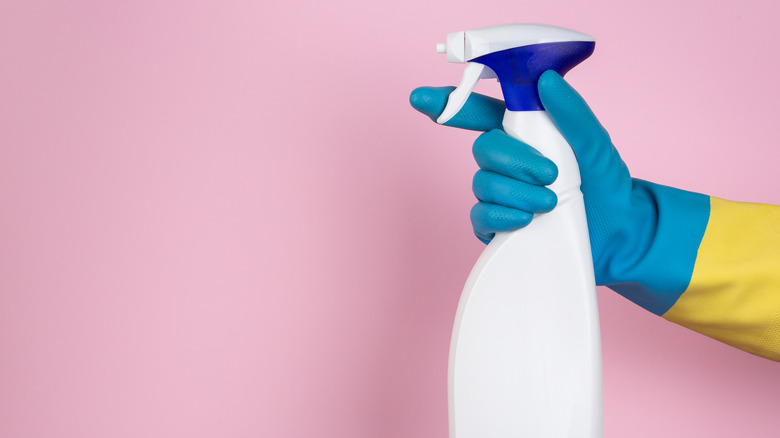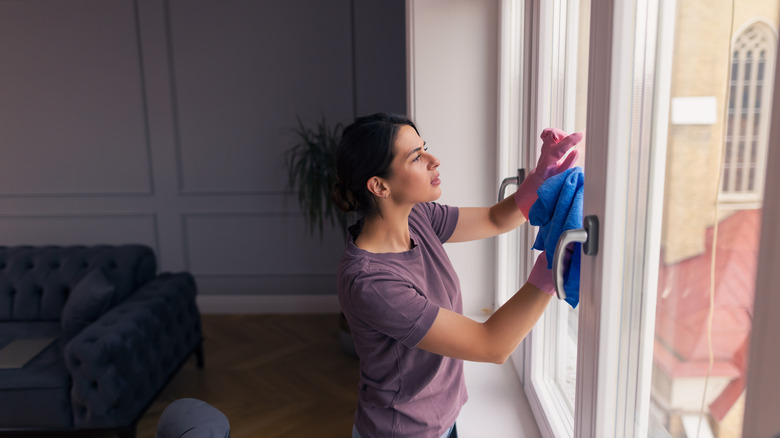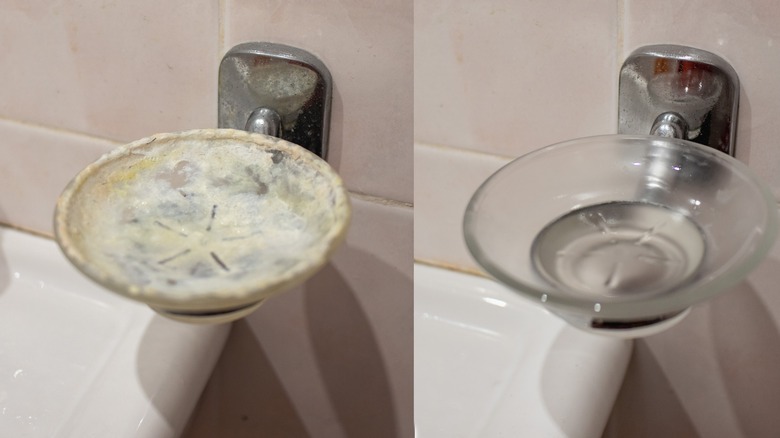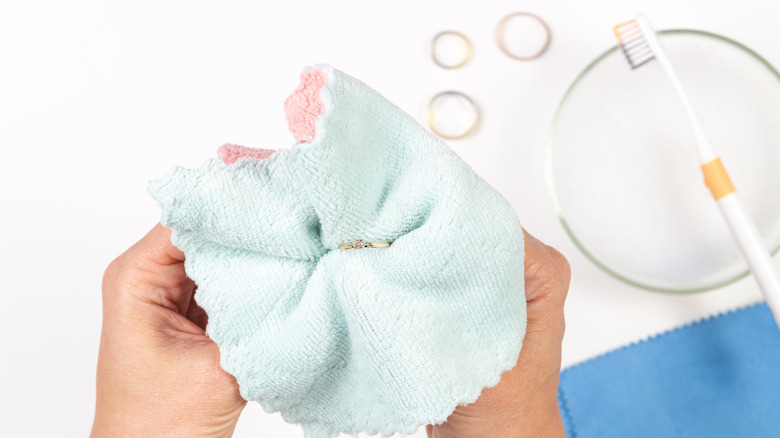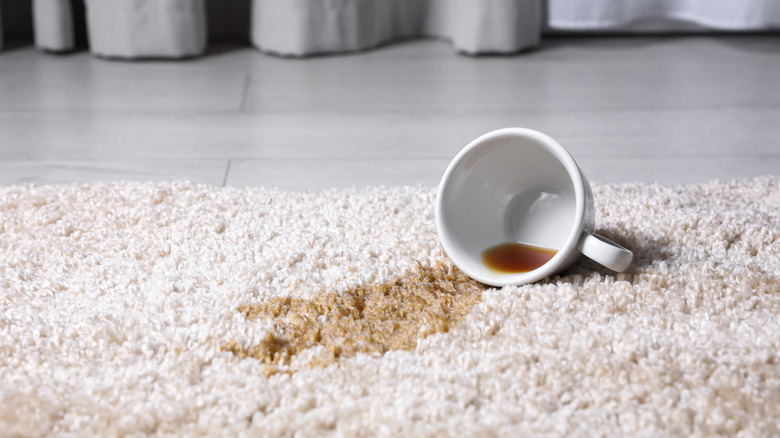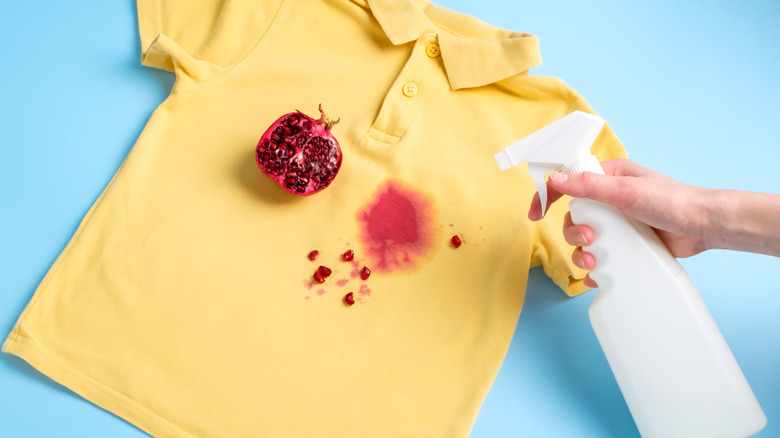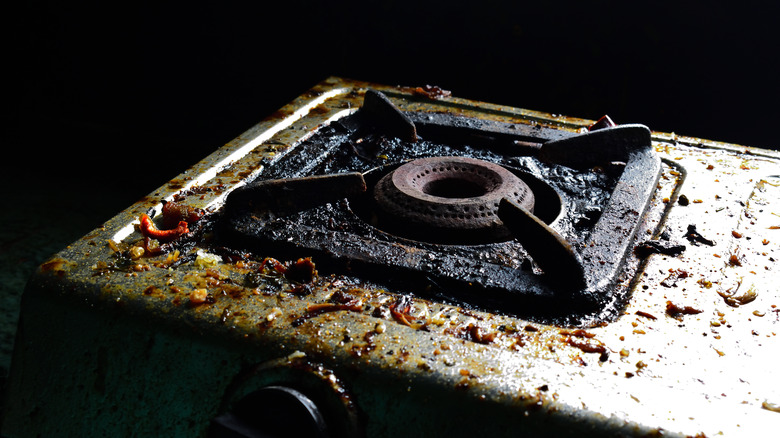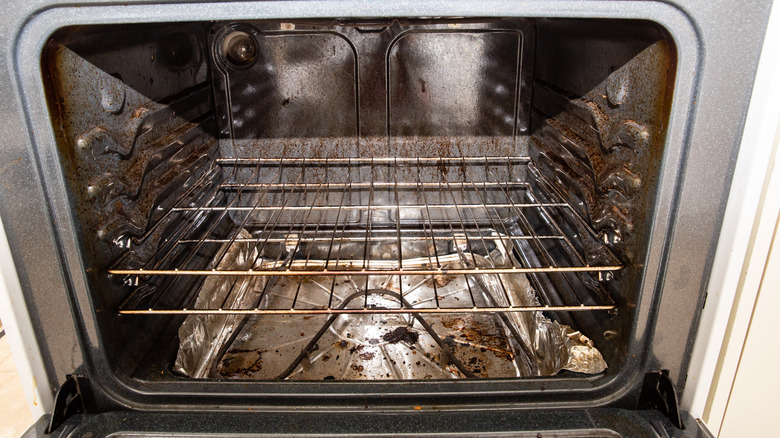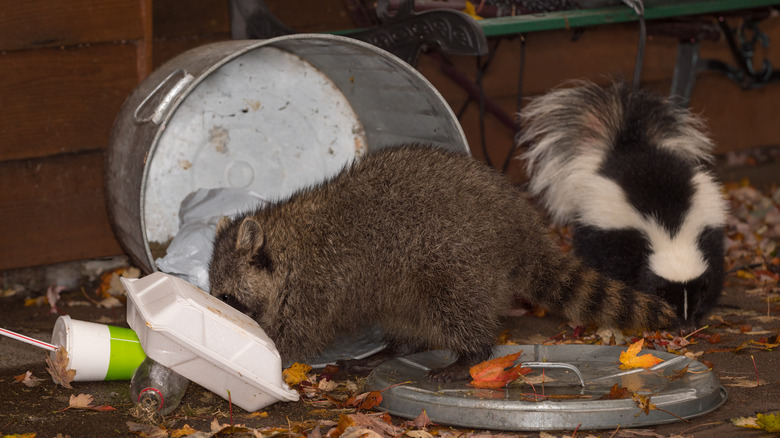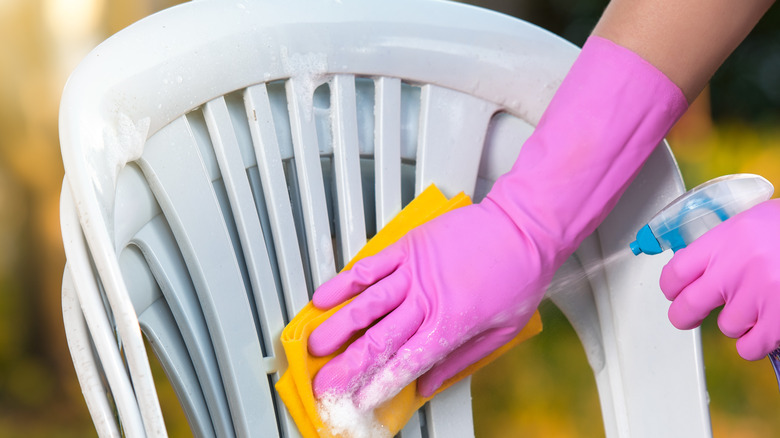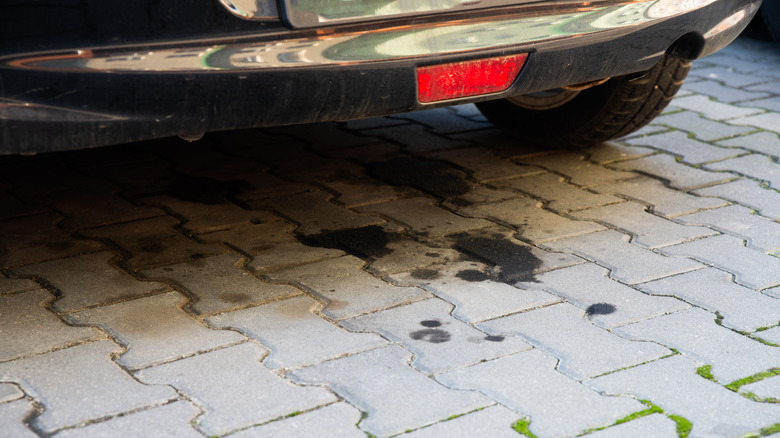10 Ways To Use Ammonia Effectively In The Home
When it comes to basic cleaning supplies, ammonia is a potent and economical option for multiple chores in the home. Networx states that ammonium hydroxide is the proper name for the liquid form of ammonia that we commonly employ as a household cleaner. Recipes for cleaning solutions typically call for a ratio of 5 to 10 percent ammonia mixed with clear water. Therefore, the strong ammonia is highly diluted when it's used for cleaning tasks. Solutions of ammonia mixed with water serve as effective cleaning agents for numerous applications in kitchens, bathrooms, basements, garages, and outdoor areas around the home.
A few guidelines and precautions apply when you use ammonia for cleaning. Ammonia produces fumes that may be harmful to the eyes, throat, and lungs. Therefore, Chemical Safety Facts recommends that you open a window to ensure ample ventilation while working with ammonia. If possible, run an exhaust fan to evacuate fumes from the area. Additional precautions include wearing protective gloves as well as eye protection. Always keep ammonia away from children and pets, as the liquid substance is toxic when ingested and the fumes are harmful when inhaled. Finally, keep in mind that you should never mix ammonia with chlorine bleach. This combination produces a highly toxic gas that can cause serious physical harm or even death.
Banish streaks and smudges from glass surfaces
Ammonia cuts through grease and grime. Therefore, it's one of the best cleaners to produce sparkling glass surfaces that are devoid of film, streaks, and smudges. In fact, many commercially available glass cleaners rely on ammonia as a primary ingredient. For this reason, Big Apple Window Cleaning suggests that you can save money by using ammonia to concoct your own homemade window cleaner.
A mixture of ammonia, water, vinegar, and liquid dishwashing soap in the proper proportions can serve as an effective cleaner for windows, mirrors, tabletops, and other glass surfaces. For minimally dirty glass, mix a solution of 1 cup of ammonia with 1 cup of warm water, 1 tablespoon of white vinegar, and 1 drop of dishwashing soap. If your glass is heavily stained or grimy, use the same recipe but increase the amount of vinegar to ½ cup. Pour the ingredients into a spray bottle and shake well before spraying it onto your glass. If your glass is exceedingly dirty, allow the cleaning solution to stay on the glass surface for several minutes before wiping it off. Due to the action of the ammonia in your DIY glass cleaner, the process should leave a clean surface with no residual film.
Remove soap scum from bathroom surfaces
In the bathroom, soap scum accumulates on glass shower doors, tubs, sinks, tiled surfaces, and metal fixtures. You can remove it with a homemade cleaning solution featuring ammonia. Tips Bulletin notes that the calcium and magnesium found in hard water produce a sticky substance when they combine with the ingredients found in soap. This stubborn, sticky mess known as soap scum adheres to hard surfaces throughout the bathroom. Ammonia is an inexpensive cleaning agent that cuts through and gets rid of soap scum.
Open the bathroom window and activate the exhaust fan before working with ammonia in the enclosed area. Then, mix a solution of 1 cup of ammonia with a few cups of warm water in a bucket or spray bottle. House Cleaning Central suggests spraying the solution onto the areas where soap scum builds up. Then, leave it for 30 minutes, but don't allow the ammonia and water solution to dry completely. Come back with a nylon-bristle brush and scrub the area that is soaked in the ammonia solution. After scrubbing, rinse the area with hot water and follow up by drying the surfaces with a soft cloth.
Make your jewelry sparkle
Ammonia is a safe and effective cleaner for fine jewelry that includes natural diamonds as well as gold and silver metals. Burdeen's Jewelry suggests mixing ¼ cup of ammonia with 1 cup of warm water to create a cleaning solution that works well on diamonds. Allow the diamond jewelry to soak in the solution for 20 to 30 minutes before gently scrubbing it with a toothbrush or jewelry cleaning brush. Finish the job by drying the diamond jewelry with a soft cloth, and rubbing all surfaces gently. Additionally, tarnished gold pieces respond well to soaking in a solution of water and dishwashing soap topped off with a few drops of ammonia. After soaking, you should rub the gold with a soft cloth to remove any residual tarnish.
Be aware that ammonia is not recommended for cleaning clarity-enhanced diamonds, as it may damage this type of stone. Jewelry Cleaners Hub adds that ammonia can damage platinum pieces, soft stones, and jewelry that's bonded by glue. For these materials, ammonia is too strong, and milder agents should be used.
Eradicate stains in carpets and upholstery
You can mix a homemade ammonia solution that successfully removes unsightly stains from carpets and upholstery fabrics. It's not a recommended procedure for cleaning the carpet in an entire room. Instead, the application of an ammonia cleaning solution is effective as a spot remover for limited, defined areas of carpets, rugs, and furniture. For example, if you spill a cup of coffee on the carpet or the sofa, ammonia can come to the rescue, removing the brown stain.
Van's Carpet advises mixing a solution of 1 cup of ammonia with 4 cups of water. According to ProLux Cleaning, you can also add a bit of vinegar and a tablespoon of liquid dishwashing soap to the solution. Place the mixture in a spray bottle and saturate the stained area of your carpet or upholstery. Open a window to ensure necessary ventilation while the ammonia is present in the room. Let the cleaning solution sit for a few minutes to soak into the fibers of the carpet or upholstery. Then, blot the area slowly with a clean cloth. Allow time for the blotting cloth to absorb the ammonia solution along with the stain. Always blot from the outer edges of the stain, working your way toward the center. This method will ensure that the stain does not spread to become an even larger eyesore.
Obliterate stains in washable fabrics
Ammonia is a successful pretreatment agent for tough stains in your dirty laundry. It won't harm your washing machine, and it does not remove the color from fabrics in the way that bleach does. Everyday Cleaning Ideas recommends two ammonia recipes for DIY, stain-removing laundry treatments. For tough grime and stains, you can use a solution of equal parts ammonia, water, and laundry detergent without bleach. Let the mixture sit for 30 minutes before thoroughly rinsing the treated areas. Make sure the stain is removed, then, launder the items in the washer like normal. For lightly stained laundry, mix ½ ounce of ammonia and 1 ounce of non-bleach detergent with 2 cups of water. This is perfect to keep on hand to pretreat any stained areas of garments. Apply the solution from a spray bottle onto the stains and wait 30 minutes before washing. Then, you can skip the rinsing step and toss the items directly into the machine.
Take precautions when using ammonia as a laundry cleaning agent. Wear gloves, and ensure plenty of ventilation. To avoid dangerous, toxic fumes, you should never mix ammonia with bleach or with laundry detergents that contain bleach. Don't use ammonia to remove stains in wool or silk fabrics, as it destroys those natural protein fibers. Of course, take care to store ammonia out of reach of inquisitive children and pets who might venture into the laundry room.
Remove grease from stove-top burners and outdoor grill grates
Use ammonia to remove the stubborn, burned-on grease that collects on stove-top burners (via The V Spot). Instead of employing elbow grease to scrub the burners with detergent, you can allow the chemical process from ammonia fumes to break down the hardened gunk overnight while you sleep. Place each burner in a zip-closure, plastic, freezer bag and add ¼ cup of ammonia. Seal the bag tightly and let it sit overnight. To avoid fumes in your home, you may want to place the bags outdoors in a protected area, away from kids and pets. With the plastic bags completely sealed, the ammonia fumes will break down the cooked-on mess that sticks to the burners. After at least 12 hours, open the bags and remove the burners. Pour the ammonia down a drain in a well-ventilated area. Then, rinse the burners with clear water, and wipe them with a cloth.
According to Fabulessly Frugal, this cleaning method works on the greasy grates from your outdoor grill. Instead of zip-closure plastic bags, you'll want to use plastic trash bags. Pour 1 cup of ammonia into the trash bag and add the grill grate. It's a good idea to double-bag each grate and seal the bags with duct tape before you let them sit for 12 to 24 hours. Then, follow the same procedure that you would use for stovetop burners, making sure to properly dispose of the ammonia and thoroughly rinse and wipe the grates.
Clean your oven
Using ammonia, you can destroy the grease and burned-on mess that collects on your oven's interior surfaces, including the racks. According to You've Got Maids, you'll need to heat your oven to 150 degrees Fahrenheit before turning it off. If it's a gas oven, turn off both the gaslight and the pilot light to ensure safety. Next, place an oven-safe bowl or pot full of water on the bottom rack. Pour 1 cup of ammonia into a second oven-safe vessel and place it on the top rack. Leave the two bowls in the oven overnight and let the vapors do their magic.
In the morning, open a window and operate an exhaust fan to provide ventilation for the next steps in the oven-cleaning process. Open the oven door and remove both containers. Discard the water, but retain the ammonia. After leaving the oven door open for about 15 minutes, you'll be able to wipe the greasy residue off the walls, floor, and racks of the oven. To do this, pour the cup of ammonia into a bucket of warm water and add a few squirts of dishwashing soap. Use a sponge or nylon scouring pad along with the ammonia mixture to wipe down all interior surfaces. The loosened grime in your oven will wipe away easily. Follow up by wiping the oven's interior with clear water and drying with a soft cloth.
Repel pesky varmints
Use ammonia to make a DIY repellent that chases away squirrels, raccoons, skunks, coyotes, armadillos, and other problem-causing wildlife. Wizard of Yards points out that small animals move away from areas where the smell of ammonia is present because it mimics the odor of a predator's urine. To repel unwanted animals from an outdoor shed, you might saturate rags with ammonia and place them in bowls around the premises. Alternatively, you can deposit cotton balls in a plastic bag and soak them in ammonia. Then, using gloves, carefully remove the ammonia-saturated cotton balls from the bag and place them around the area. Similarly, you can soak a rag in ammonia and drop it into the bottom of your trashcan to deter night-raiding raccoons.
Greenwood Village suggests a similar application for an ammonia-based wildlife repellent. Use a small plastic container with a lid, and puncture a few small holes in the top. Inside the container, place a rag soaked in a solution of ⅔ cup of ammonia and ⅓ cup of water. Leave the container in a location where the pesky animals live. For nuisance animals who tunnel underground, you can apply the ammonia-and-water solution through a hose. First, stuff the opening of the animal's hole with a few pieces of crumpled paper. Then, insert a hose a few feet into the tunnel and pour the solution in so it can run underground. This should drive the animal to vacate the tunnel and move on to a new location.
Destroy mold and mildew on outdoor furniture
In warm and humid conditions, mold and mildew grow on outdoor furniture. When it's time to spruce up the porch and patio areas, ammonia is an excellent cleaner to tackle the job. According to Green Orchard Group, ammonia's potency as a mold killer may be attributed to its high pH level — between 11 and 13. Typically, the living spores in mold will survive a pH level of only about 7. Killing the mold spores is a crucial step in bringing your outdoor furniture back to serviceable condition.
Home Healthy Homes notes that ammonia is most effective as a mold killer when it's used on hard surfaces. To remove mold from outdoor furniture, spray the hard surfaces with a solution of one part clear ammonia and one part water. Allow the solution to sit on the surfaces for a few hours. Then, finish the job by rinsing with water from a bucket or garden hose and wiping the furniture with a dry cloth.
Put an end to stained concrete surfaces
Ammonia is an effective cleaner to remove ugly stains from unsealed concrete floors, patios, walkways, and driveways. You can start by mixing a solution of 1 cup of ammonia in 1 gallon of water. Splash the solution onto the stained concrete to saturate the area and allow the solution to soak in for a few minutes. Then, scrub the concrete with a stiff brush and rinse it with a garden hose. If the stain is still visible, you may need to repeat the process.
Occasionally, cars and trucks leak oil and other automotive fluids onto driveways. These fluids may create stubborn and unsightly stains that detract from your home's curb appeal. The Columbus Dispatch recommends ammonia as a cleaning agent for concrete stains, even when the stains do not respond to power washing. Mix ammonia and baking soda to create a thick paste. Spread the paste on the oil stain and scrub with a stiff brush to work the paste into the concrete surface. Allow the paste to sit until it's dry and follow up by rinsing it away with a garden hose. For complete stain removal, you may need to repeat the process. Of course, it's necessary to keep children and pets away from the ammonia-saturated area while it's drying.
